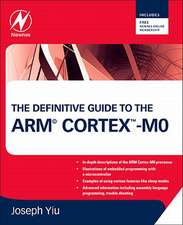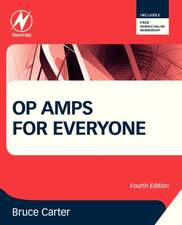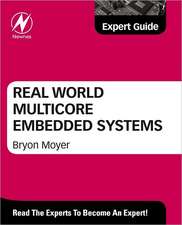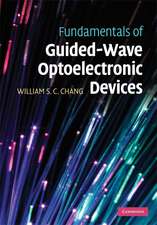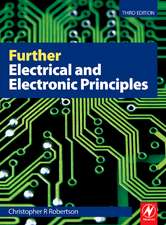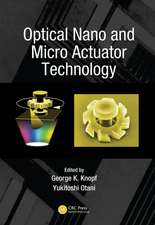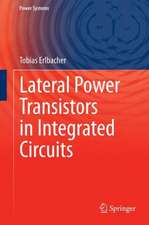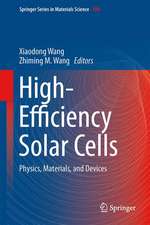Organic Light-Emitting Devices: A Survey
Editat de Joseph Shinaren Limba Engleză Paperback – 9 oct 2011
| Toate formatele și edițiile | Preț | Express |
|---|---|---|
| Paperback (1) | 641.71 lei 43-57 zile | |
| Springer – 9 oct 2011 | 641.71 lei 43-57 zile | |
| Hardback (1) | 647.27 lei 43-57 zile | |
| Springer – 31 oct 2003 | 647.27 lei 43-57 zile |
Preț: 641.71 lei
Preț vechi: 754.95 lei
-15% Nou
Puncte Express: 963
Preț estimativ în valută:
122.79€ • 128.53$ • 102.20£
122.79€ • 128.53$ • 102.20£
Carte tipărită la comandă
Livrare economică 31 martie-14 aprilie
Preluare comenzi: 021 569.72.76
Specificații
ISBN-13: 9781441929600
ISBN-10: 1441929606
Pagini: 328
Ilustrații: XVI, 309 p. 33 illus.
Dimensiuni: 155 x 235 x 17 mm
Greutate: 0.45 kg
Ediția:2004
Editura: Springer
Colecția Springer
Locul publicării:New York, NY, United States
ISBN-10: 1441929606
Pagini: 328
Ilustrații: XVI, 309 p. 33 illus.
Dimensiuni: 155 x 235 x 17 mm
Greutate: 0.45 kg
Ediția:2004
Editura: Springer
Colecția Springer
Locul publicării:New York, NY, United States
Public țintă
ResearchCuprins
1 Introduction to Organic Light-Emitting Devices.- 1.1 Introduction.- 1.2 Basic Electronic Structure and Dynamics of ?-Conjugated Materials.- 1.3 Basic Structure of OLEDs.- 1.4 OLED Fabrication Procedures.- 1.5 Materials for OLEDs & PLEDs.- 1.6 Basic Operation of OLEDs.- 1.7 Carrier Transport in OLEDs.- 1.8 The Efficiency of OLEDs.- 1.9 Degradation Mechanisms.- 1.10 Outlook for OLEDs.- References.- 2 Molecular LED: Design Concept of Molecular Materials for High-Performance OLED.- 2.1 Introduction.- 2.2 OLED Development from the 1960s to the 1980s.- 2.3 Working Mechanisms of OLED.- 2.4 Design of Multilayer Structures.- 2.5 Molecular Materials for OLED.- 2.6 Future Possibilities of OLED.- 2.7 Conclusion.- References.- 3 Chemical Degradation and Physical Aging of Aluminum(III) 8-Hydroxyquinoline: Implications for Organic Light-Emitting Diodes and Materials Design.- 3.1 Introduction.- 3.2 Chemical Stability of OLED Materials.- 3.3 Morphological Stability of Organic Glasses in LEDs.- 3.4 The Effect of Aging Processes on OLED Performance.- References.- 4 Organic Microcavity Light-Emitting Diodes.- 4.1 Introduction.- 4.2 Types of Microcavities.- 4.3 Planar Microcavity LEDs.- 4.4 Single Mode and Multimode Planar Microcavity LEDs.- 4.5 Intensity and Angular Dependence in Planar Microcavities.- 4.6 Materials for Organic Microcavity LED Displays.- 4.7 Summary.- References.- 5 Light-Emitting Diodes Based on Poly(p-phenylenevinylene) and Its Derivatives.- 5.1 Introduction.- 5.2 The Electronic Structure of PPV.- 5.3 Synthesis of PPV and Derivatives.- 5.4 Single-Layer LEDs.- 5.5 Multiple-Layer Polymer LEDs.- 5.6 Transport and Recombination in Polymer LEDs.- 5.7 Optical Properties of Polymer LEDs.- 5.8 Novel LED Structures.- 5.9 Prospects for Applications of PPV-Based LEDs.- 5.10Conclusions.- References.- 6 Polymer Morphology and Device Performance in Polymer Electronics.- 6.1 Introduction.- 6.2 The Control of Polymer Morphology.- 6.3 The Control of Device Performance via Morphology Control..- 6.4 Conclusions.- References.- 7 On the Origin of Double Light Spikes from Polymer Light-Emitting Devices.- 7.1 Introduction.- 7.2 Experimental.- 7.3 Results and Analysis.- 7.4 Discussion.- 7.5 Conclusions.- References.- 8 Electroluminescence with Poly(para-phenylenes).- 8.1 Introduction.- 8.2 Physical Properties of Oligophenyls and Polyphenyls.- 8.3 Electroluminescence.- 8.4 Conclusions.- References.- 9 Direct and Alternating Current Light-Emitting Devices Based on Pyridine-Containing Conjugated Polymers.- 9.1 Introduction.- 9.2 Experiments.- 9.3 Results and Discussion.- 9.4 Summary and Conclusion.- References.- 10 Polyfluorene Electroluminescence.- 10.1 Introduction.- 10.2 Synthesis and Characterization of Polyfluorene.- 10.3 Electroluminescence.- 10.4 Concluding Remarks.- References.
Textul de pe ultima copertă
Although it has long been possible to make organic materials emit light, it has only recently become possible to do so at the level and with the efficiency and control necessary to make the materials a useful basis for illumination in any but the most specialized uses. The early electroluminescent panels and cells provided reasonably bright light, but required high operating voltages, produced only a narrow range of colors, and had severely limited lifetimes. Recent developments, however, make it possible to manufacture organic light-emitting devices that are thin, bright, efficient, and stable and that produce a broad range of colors.
This book surveys the current status of the field. It begins with an overview of the physics and chemistry of organic light emitting devices by J. Shinar and V. Savvateev. It then turns to the design of molecular materials for high performance devices (C. Adachi and T. Tsutsui) and a discussion of chemical degradation and physical aging (K. Higginson, D.L. Thomsen, B. Yang, and F. Papadimitrakopoulos). A. Dodabalanpur describes microcavity LEDs, and Y. Shi, J. Liu, and Y. Yang discuss polymer morphology and device performance. Various aspects of devices based on polyparaphenylenes are discussed in chapters by N.C. Greenham and R.H. Friend; by Chayet, Savvateeyv, Davidoff and Neumann; and by S. Tasch, W. Graupner, and G. Leising. The book concludes with a discussion of devices based on pyridine-containing conjugated polymers by Y.Z. Wang, D. Gebler, and A.J. Epstein
This book surveys the current status of the field. It begins with an overview of the physics and chemistry of organic light emitting devices by J. Shinar and V. Savvateev. It then turns to the design of molecular materials for high performance devices (C. Adachi and T. Tsutsui) and a discussion of chemical degradation and physical aging (K. Higginson, D.L. Thomsen, B. Yang, and F. Papadimitrakopoulos). A. Dodabalanpur describes microcavity LEDs, and Y. Shi, J. Liu, and Y. Yang discuss polymer morphology and device performance. Various aspects of devices based on polyparaphenylenes are discussed in chapters by N.C. Greenham and R.H. Friend; by Chayet, Savvateeyv, Davidoff and Neumann; and by S. Tasch, W. Graupner, and G. Leising. The book concludes with a discussion of devices based on pyridine-containing conjugated polymers by Y.Z. Wang, D. Gebler, and A.J. Epstein


